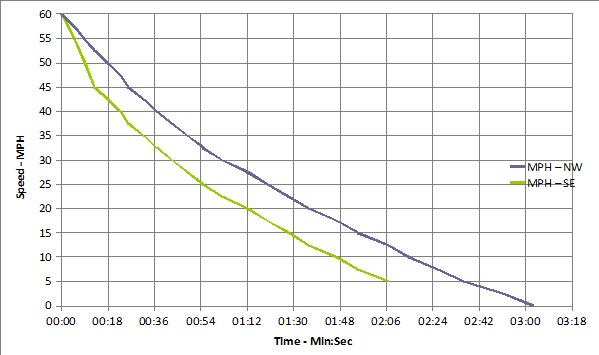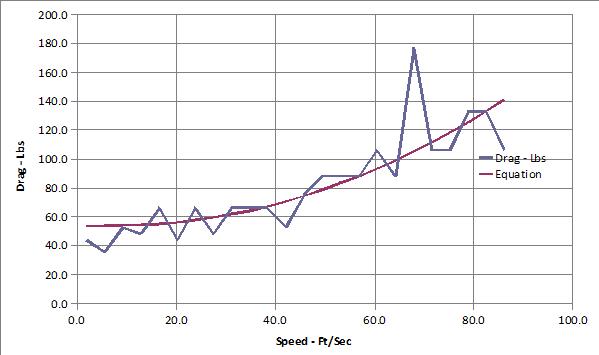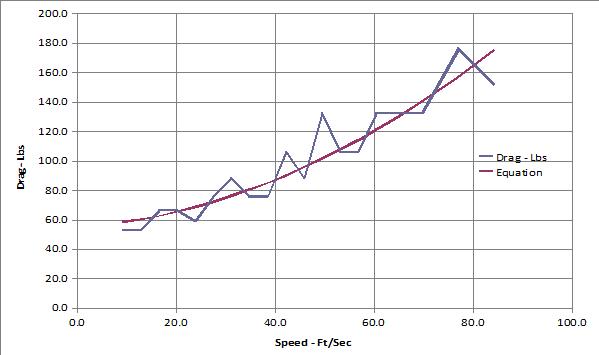I finally got an opportunity to do a coastdown test of my Canyon. Flat roads don't seem to exist in Northern Wisconsin, but I finally found one in Central Wisconsin. A stretch of Highway 73 located a few miles west of Plainfield is flat to less than five feet and was lightly traveled on that day.
Elevation 1060 feet, temperature 17 deg F, wind 5 to 7 MPH from the SE. That particular stretch of road ran NW. Tires at 48 PSI, estimated gross weight with gas, luggage, and people was 4650 lbs.
My brother sat in the back seat and aimed a video camera at the speedometer. Data reduction consisted of watching the video and recording the time at which the speedo needle passed 60, 57.5, 55, etc MPH. The data was entered into a spreadsheet.
Ran the test once in each direction, so had a direct tailwind and a direct headwind. The following image shows the speed vs time for the two runs.

The wind speed was only 5 to 7 MPH according to wunderground.com and barely noticeable according to personal observation, but that was enough to significantly affect the two coastdown runs. I stopped the second coastdown before getting to a full stop because of traffic.
The rate of deceleration is the change in speed (2.5 MPH) divided by the time for that speed change. With the speed converted to Ft/Sec, the result came out in Ft/Sec^2. Dividing the deceleration by 32.2 and multiplying by the total weight (4650 lbs) gives the total drag force at that speed.
The following two images show the drag vs speed for the two runs along with the best fit equation. The first image is with the tailwind, the second image with the headwind. Note that how much effect an extremely light breeze has on the total drag. A 5 to 7 MPH wind feels almost like a dead calm.


An equation of the form:
Drag = (Airspeed)^2 + Rolling Resistance was fit to both sets of data using least squares. The airspeed was actual speed minus windspeed in one direction and actual speed plus windspeed in the other direction. Windspeed was a parameter and part of the least squares process.
The result was this equation: Drag = 0.0143 X Airspeed^2 + 0.0116 X Mass. Since the total mass was 4650 lbs, the equation can also be shown as: Drag = 0.0143 X Airspeed^2 + 54 lbs.
This approach implies that the total rolling friction (Crr plus wheel bearings plus brake drag plus differential gears plus driveshaft friction plus transmission friction) is 0.0116 times the total weight of the truck.
The CdA can be calculated from this equation. Pick an arbitrary speed, say 100 ft/sec. The aero drag is 0.0143 X 100^2 = 143 lbs. The air density at 17 deg F at 1060 feet elevation is 12.4 lbs/ft^3, so the velocity pressure at 100 ft/sec is 0.5 X 0.0806 lbs/ft^3 / 32.2 X 100^2 = 12.52 lbs/ft^2. The CdA is then 143 / 12.52 = 11.4 ft^2.
The frontal area is estimated to be 67.6" X 65.2" X 0.84 / 144 = 25.7 ft^2. The Cd is estimated to be 11.4 / 25.7 = 0.44.
I suspect that much of the bearing and driveline drag is proportional to speed. If so, adding a linear term to the regression equation would increase overall accuracy. Doing that would require a better data set - start from a higher speed and both runs need to go to a full stop.